Corn is King, but Soybeans Have an Impact Too
September 16, 2016

Harvesting soybeans. Photo by J. Laughlin.
Corn has always been king in Iowa, but the state once had a wide variety of small grains, vegetables, fruit (Iowa was once the nation’s biggest apple producer), and forage legumes (alfalfa and clovers). In the 1950s, soybeans began to displace these other crops, and now its area nearly rivals that of corn in some years.
Iowa’s streams, lakes, and aquifers suffer from excess nitrate and phosphorous. Early water-quality data from around 1900 to 1950 show stream nitrate slowly but steadily increasing, as more of the state’s area was brought into crop production. This increase seemed to accelerate in the 1960s and continued until about 1990. Perhaps not coincidentally, this coincides with the period of soybean expansion in Iowa.
Because corn production requires large inputs of these nutrients, much research over the past 40 years has focused on how we can better manage fertilization of corn. Journal articles in 2009 (1) and 2016 (2) seemed to show there was more to the story—the role of soybeans in transport of nitrate from farmed fields to the stream network.
Recently another article (3) published by IIHR researchers provides more evidence that soybean has been a key contributing factor in nitrate levels observed over the past 50 years. Authors Gabriele Villarini, Keith Schilling, and Chris Jones used a statistical model that evaluated a variety of agricultural, hydrologic, and climatic variables and their possible connection to Raccoon River nitrate since 1974. The conclusion: soybean area and river baseflow (discharge volumes between storm events) are the main drivers of nitrate.
Interestingly, river baseflow has increased in recent decades and may be hydrologically-linked to soybean area (4). Compared to corn, soybean is a smaller plant with a shorter growing season. This means it uses less water. A larger portion of the rainwater travels through the soil profile (where it can dissolve nitrate) and into drainage pipes and the stream network.
The researchers aren’t suggesting that farmers should stop growing soybeans. The crop is Iowa’s largest overseas export, with beans and meal exports exceeding $3.4 billion in 2013. This exceeds Iowa’s overseas exports for pork ($2 billion) and corn ($1.1 billion) combined (5). The research is another indication, however, that conservation practices focused on soybean (and not just fertilization of corn) may improve water quality in surprising ways.
- Hatfield, J.L., L.D. McMullen, and C.S. Jones, 2009. Nitrate-nitrogen patterns in the Raccoon River basin related to agricultural practices. J. Soil Water Conserv. 64:190-199.
- Jones, C.S., A. Seeman, P.M. Kyveryga, K.E. Schilling, A. Kiel, K-S. Chan and C.F. Wolter. 2016. Crop rotation and Raccoon River nitrate. J. Soil Water Conserv. 71:206-219.
- Villarini, G., C.S. Jones, and K.E. Schilling. 2016. Soybean area and baseflow driving nitrate in Iowa’s Raccoon River. J. Env. Quality. doi: 10.2134/jeq2016.05.0180.
- Zhang YK and K.E. Schilling. 2006. Increasing streamflow and baseflow in Mississippi River since the 1940s: Effect of land use change. Journal of Hydrology. 324(1):412-22.
- http://www.fas.usda.gov/sites/default/files/2015-02/iowa_tpp_feb_2015.pdf.



